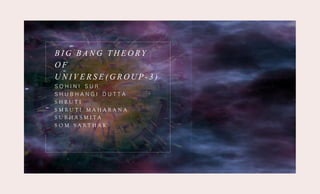eng f.pdf
- 1. B I G B A N G T H E O R Y O F U N I V E R S E ( G R O U P - 3 ) S O H I N I S U R S H U B H A N G I D U T T A S H R U T I S M R U T I M A H A R A N A S U B H A S M I T A S O M S A R T H A K
- 2. A B B E G E O R G E S ( 1 8 9 4 - 1 9 6 6 ) ? Belgian cosmologist . ? Professor of physics at the catholic university of Leuven. ? He proposed the theory of the expansion of the universe, widely misattributed to Edwin Hubble.
- 3. According to the big bang theory: ? The universe originated approximately 13.8 billion years ago from a singularity, an extremely hot and dense point. ? At this moment, all the matter, energy, space, and time in the universe were concentrated at a single point. ? Shortly after the initial moment of the Big Bang, the universe began to rapidly expand. ? As it expanded, it cooled down, allowing particles and elements to form.
- 4. B E G I N N I N G : ? The big bang theory is prevailing cosmological model for the universe from the earliest known periods through its subsequent large-scale evolution. ? The universe began as a very hot , small, and dense, with no stars, atoms, form, or structure(called a " Singularity"). ? The Big Bang is a scientific theory about how the universe started, and then made the groups of stars (called galaxies) we see today This Photo by Unknown author is licensed under CC BY-SA.
- 5. F O R M A T I O N O F G A L A X I E S A N D S T A R S : Over time, the force of gravity caused matter to clump together, forming galaxies, stars, and other celestial structures within the expanding universe. Matter coalesced when the universe cooled and became “transparent” 380,000 years after the Big Bang. Structures like stars and galaxies formed as early as 200 million years after the Big Bang. Atoms formed from tiny particles, and then atoms grouped together to form stars and galaxies. Galaxies begin as small clouds of stars and dust swirling through space.As other clouds get close, gravity sends these objects careening into one another and knits them into larger spinning packs. Stars develop inside a protogalaxy when clouds of gas mix and collide. If the stars in a protogalaxy form all at once, then the mature galaxy essentially retains the spherical shape of the protogalaxy and becomes an elliptical galaxy. Spiral galaxies occur when the stars inside the protogalaxy arise at different intervals.
- 6. H U B B L E ' S L AW: ? Hubble's law, also known as the Hubble– Lema?tre law, is the observation in physical cosmology that galaxies are moving away from Earth at speeds proportional to their distance. ? In other words, the farther they are, the faster they are moving away from Earth. The velocity of the galaxies has been determined by their redshift, a shift of the light they emit toward the red end of the visible spectrum. ? The motion of astronomical objects due solely to this expansion is known as the Hubble flow. It is described by the equation v = H0D, with H0 the constant of proportionality—the Hubble constant. ? The Hubble constant is most frequently quoted in (km/s)/MPC. This Photo by Unknown author is licensed under CC BY.
- 7. B I B L I O G R A P H Y: ? Hubble's law - Wikipedia ? The big bang theory | PPT (slideshare.net) ? How Did Galaxies Form? | Astronomy.com
- 8. THANK YOU







